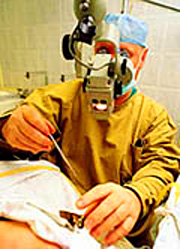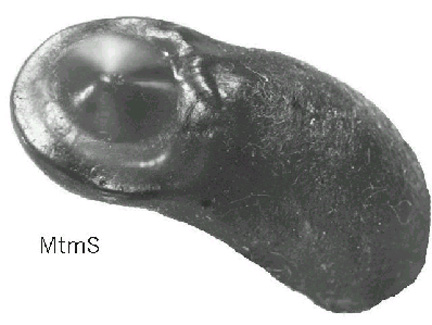



Variants of "Surgical Angle" of approach
to the Antrum


 |
Middle Ear,Tympanic Membrane, Infections
(Topic 205) of the eMedicine Texbook. Authored by Yuri P Uliyanov, MD, PhD, Moscow, Russia. |
||||||||||||||||||||||||||||||||||||||||||||||
|
||||||||||||||||||||||||||||||||||
|
|
AUTHOR INFORMATION | Section 1 of 12 |
Authored by Yuri P Uliyanov, MD, PhD, Professor, Department of Otolaryngology, Center for Endosurgery and Lithotripsy, Moscow Coauthored by John Schweinfurth, MD, Assistant Professor, Division of Otolaryngology, Penn State University Hershey Medical Center
Yuri P Uliyanov, MD, PhD, is a member of the following medical societies: American Academy of Otolaryngology-Head and Neck Surgery, and []
Edited by Carol A Bauer, MD, Assistant Professor, Department Of Surgery Otolaryngology, Southern Illinois University School Of Medicine; Francisco Talavera, PharmD, PhD, Department of Pharmacy, Creighton University;
Gerard J Gianoli, MD, Clinical Associate Professor, Department of Otolaryngology-Head and Neck Surgery, Tulane University School of Medicine;
Christopher L Slack, MD, Consulting Staff, Department of Otolaryngology-Head and Neck Surgery, David Grant Medical Center;
and Arlen D Meyers, MD, MBA, Professor, Department of Otolaryngology-Head and Neck Surgery, University of Colorado, University Hospital
Background: The extremely thin and delicate tympanic membrane (TM) is easily traumatized, although it is responsible for a great number of important functions. Diseases of the TM cause many inconveniences for patients, depriving them of their capacity for work and for enjoyment of life. Prevalence of these diseases results in increased incidence of both otitis media and externa. To prevent recurrence, competent treatment by a qualified specialist is very important. In addition, patients must observe all recommendations from their physicians.
Myringitis, or inflammation of the TM, is accompanied by hearing impairment and a sensation of stuffiness in the ear. Earache is related to the inflammation stage. In cases of chronic myringitis, earache is sometimes absent. After a 3-week duration, acute myringitis acquires the subacute character, and, within 3 months, chronic myringitis develops.
The TM lies across the end of the external canal and looks like a flattened cone with its tip (apex) pointed inward. The edges are attached to a ring of bone, the tympanic annulus. The angle of incline of the TM is over 30 degrees in newborns. In addition, the TM in newborns is thicker than it is in adults. Therefore, if the EAC in the newborn is narrow, it is difficult to examine the TM in order to make a diagnosis.
The diameter of the TM is about 8-10 millimeters. Its outer surface is slightly concave. (See Picture 1.) The edge of the membrane is thickened and attached to a groove in an incomplete ring of bone, the tympanic annulus, which almost encircles it and holds it in place. (See Picture 2.)
The uppermost small area of the membrane, where the ring is open, is slack and is called the pars flaccida. The far greater portion is tightly stretched and is called the pars tensa. The loose part of the TM, or the pars flaccida, borders on the pars tensa from above and is considerably smaller (about one eighth the size of the pars tensa). (See Picture 3.)
Author's Email: Yuri P Uliyanov, MD, PhD ![]()
Editor's Email: Carol A Bauer, MD
![]()
INTRODUCTION
Section 2 of 12
![]()
![]()
![]()
For Complete contents have a look
into the eMedicine Textbook
Drug Category: Analgesics. Myringitis is quite painful, and patients frequently request analgesics. Ortophenum or Acetaminophen with Codeine (Tylenol #3) is commonly prescribed. See also see Otitis Media, External Ear Infections, External Ear, Malignant External Otitis, and External Ear, Inflammatory Diseases.
Drug Category: Acidifying agents. Good results occur with use of acidifying agents such as acetic acid solution. See External Ear Infections, External Ear, Malignant External Otitis, and External Ear, Inflammatory Diseases. Drug Category: Analgesics - Drug Category: Analgesics, acidifying agents. See also the following chapters: Middle Ear, Otitis Media with Effusion, Medical Treatment; Middle Ear, Otitis Media with Effusion, Surgical Treatment; External Ear, Inflammatory Diseases; and External Otitis; Complications of Otitis Media.
Drug Category: Antibiotics. Controlled studies of effective antibiotics in various countries demonstrate around 80-90% efficacy. See also Otitis Media.
Drug Category: Drug Category: Regulation of the muco-epidermal conflict. Drug Name Analgesics- Ortophenum (Voltaren, Diclofenac-natrium) has anti-inflammatory, antipyretic, and analgesic effects. In terms of their anti-inflammatory and antipyretic activity, they are much stronger than Acidum Acetylsalicylicum, Ibuprofen, and Butadionum. Adult Dose 25-50 mg 2-3 times/d Pediatric Dose 15 mg in tab or 3 mL 2.5% in amp for parenteral Contraindications Documented hypersensitivity; ulcer of the stomach or duodenum Interactions Do not administer with acidum acetylsalicylicum, which reduces efficacy of Ortophenum Pregnancy
A - Safe in pregnancy
Precautions Contraindicated in the first trimester of pregnancy; discontinue use if nausea, vomiting, malaise, or abdominal colic occur Drug Name Sol. Ac.salicylici.- Sol. Ac.salicylici spirituosae 1% drops may be used as a local antiseptic and keratolytic with some benefit. Adult Dose 2-3 gtt q4-6h in the auditory canal Pediatric Dose 2-3 gtt q4-6h in the auditory canal Contraindications Documented hypersensitivity Interactions Documented hypersensitivity Pregnancy
C - Safety for use during pregnancy has not been established.
Precautions For external use only; discontinue use drops cause earache
![]()

